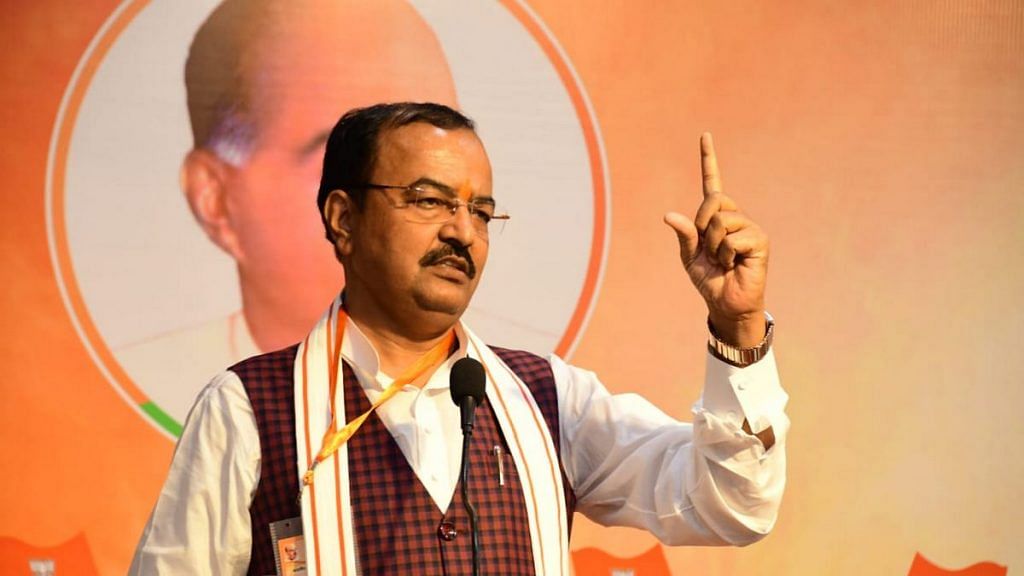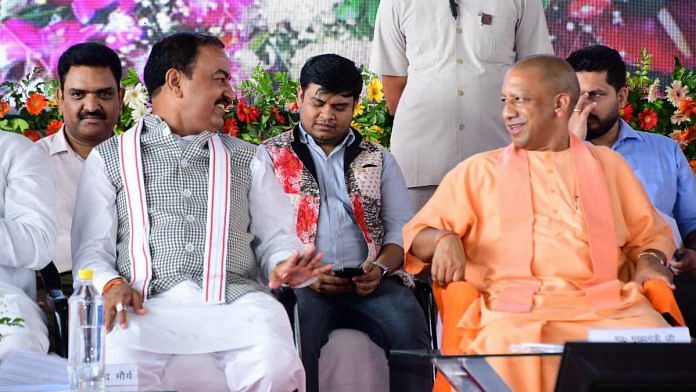Delhi/Lucknow: Uttar Pradesh Deputy Chief Minister Keshav Prasad Maurya seems to have a new mantra of sorts: sangathan sarkar se bada hai (the organisation/ party is greater than the government). Or, perhaps, it’s a veiled message for Chief Minister Yogi Adityanath.
This Sunday, at a parichay baithak (introductory meeting) in honour of Dharampal Singh, the newly appointed state BJP general secretary (organisation), Maurya delivered a message to a gathering of 38 MPs and MLAs from the Braj and western UP region: “Sangathan sarkar se bada hai. Sarkar mein log jo jate hain, sangathan hi unhe bhejta hai.” (The organisation, i.e. the BJP, is greater than the government. Those who go into the government are sent by the organisation.)
That same day, he also tweeted the same line: Sangathan sarkar se bada hai. And he reinforced this message again at a meeting of MPs and MLAs of the Awadh region in Lucknow Tuesday.
The somewhat cryptic line has invited intense speculation in Lucknow’s corridors of power.
Some party leaders point to the fact that incumbent UP BJP president Swatantra Dev Singh has completed his tenure, and now Maurya (who was state chief ahead of the 2017 elections) is a contender for the post.
He has met top BJP leaders in Delhi in this regard, party sources claim. Earlier this month, Maurya had replaced Singh as the leader of the legislative council.
Further, Maurya’s message is also being interpreted as a dig at Yogi Adityanath at a time when it’s rumoured that the BJP high command wishes to cut the CM down to size.
Speaking to ThePrint, a minister in the Yogi cabinet said: “Do you think that Maurya can relay such cryptic messages without the party high command wanting him to? It means the high command wants a greater balance of power in the state, and that it should not be concentrated only in the hands of one person. Swatantra Dev Singh shares a good equation with the CM… replacing him with Maurya could restore some balance in the power dynamics in the state.”
A senior party leader added that ahead of the 2024 Lok Sabha elections, it is particularly important that there are “checks and balances” in place. “Maurya is a trusted man of [Union home minister] Amit Shah. The party’s top priority right now is to win at least 60 out of the 80 Lok Sabha seats in UP. Any mishandling could jeopardise the party’s prospects in the country,” he said.
In this context, some party insiders say, Maurya, an influential OBC leader, is attempting to fashion himself as an alternative to Yogi, who belongs to the Thakur community, in UP.
Only last week, at a function also attended by Yogi, he went all out crediting BJP national general secretary Sunil Bansal for the party’s 2017 win in UP.
He didn’t say the words, but here too, his message seemed to be that the organisation is greater than its individual leaders.
In 2017, Maurya was the state party president and Bansal was the general secretary (organisation) in Uttar Pradesh. Bansal, like Maurya, is close to Shah and reportedly had a strained relationship with Yogi during his tenure in UP.
On the record, though, BJP leaders deny that there are any factional politics at play.
When asked about a rift between the CM and his deputy, former state BJP president and Rajya Sabha MP Laxmikant Bajpai said that too much shouldn’t be read into Maurya’s remarks.
“Maurya is a prominent leader of the party. He was only reinforcing to the cadre that we are here only because of them, and that being in power, we should not forget the organisation. There is no power struggle. We are all working to achieve the party target of winning more than 75 seats in the Lok Sabha election,” Bajpai said.
Also read: Message for Modi & Shah? Why Yogi is silent on being kept out of BJP parliamentary board
‘Face of OBCs’
Keshav Prasad Maurya lost the 2022 UP assembly election from his constituency, Sirathu, but was nevertheless instated as a one of the state’s two deputy CMs (the other is Brajesh Pathak). Since UP has a bicameral legislature, he was inducted as an MLC in June.
This, according to party sources, is because of his stature as the BJP’s “OBC face” in UP, especially at a time when the party is prioritising these communities in its caste arithmetic.
“Only four months ago, Keshav Maurya was inducted as Deputy Chief Minister in the state government. What has happened in four months that the BJP high command is now thinking of making him the state party president? He was inducted despite losing elections so that he could balance the caste representation in the council of ministers. Amit Shahji has cultivated him as the face of OBCs in the state,” a second senior leader said. “In four months, the BJP high command did not find anyone else to be a suitable choice to lead the organisation.”

The minister who was quoted earlier said that Maurya enjoyed the blessings of the high command for good reasons, and deserved to be elevated in the party.
“Not only is he the face of the OBCs, his Hindutva credentials are strong and he played an important role in the Ram Janmabhoomi movement. He is also an accessible politician. He has a bright future — if not as an alternative to Yogi, then for a bigger role in the future,” the minister said.
A second minister in the Yogi cabinet, however, speculated that Maurya was in a good position to present himself as an “alternative” to Yogi Adityanath.
“Maurya proved his mettle in 2017, when under his presidency, the BJP won more than 300 seats in UP — it was a historic mandate. If the high command asks him to lead the organisation (in UP) again, it will show their trust in his abilities,” the minister said.
He added that Maurya also had a chance of gaining mass popularity as an OBC leader, much as the late former chief minister Kalyan Singh did back in the 90s.
“When Kalyan Singh could become the Hindu hriday samrat (king of Hindu hearts) with the help of the Lodh community, who account for about 3 per cent of the votes, the deputy CM can leverage the Maurya and Saini votes, who make up 6 per cent. He can establish himself as one of most prominent OBC leaders of not only UP, but at the national level too.”
Yogi vs. Maurya
It’s worth recalling that after the BJP’s victory in the 2017 assembly election, Maurya was a contender for the chief ministerial position.
Back then, parallels were drawn about his similarities with Prime Minister Narendra Modi, such as both belonging to the OBC community and running tea stalls when they were younger.
However, if Maurya was anticipating being ‘rewarded’ with the CM’s post after the elections, he was disappointed and had to settle for a position one rung down.
In UP’s political circles, it is often whispered that Maurya resents Yogi hogging the spotlight since he believes he has worked harder for the party as its state president ahead of the 2017 elections.
There have been several signs of apparent friction between the two leaders. For instance, when Maurya headed the Public Works Department (PWD) in the first Yogi government, the chief minister was known to hold meetings with its officials and rebuke them for shortfalls in their work. Maurya skipped most meetings held by the CM.
Then, in 2019, Maurya wrote a letter to Adityanath, alleging massive corruption in the Lucknow Development Authority (LDA), which deals with land allotments and housing schemes. This was seen as a direct challenge since the LDA is headed by the chief minister. It has also been reported that an appointment to the post of managing director in his department was decided by Yogi, only to be rolled back when Maurya complained to the BJP high command. It is also rumoured that various cases against Maurya were closed upon instructions from Delhi after he argued that the same had been done for Yogi.
In June 2021, a comment from Maurya himself reignited speculation that all was not well between the two power centres of UP.
Maurya had remarked to mediapersons that only the BJP parliamentary board and the national leadership could decide under whom the 2022 assembly elections would be fought. “It does not matter under whose leadership the election is being fought. The BJP is the largest party in the world. It is not a private limited company,” he had said.
Maurya had brushed aside questions about a rift with Yogi, but many read between the lines.
Later that month, BJP insiders say, Yogi was nudged by top RSS and BJP leaders to mend fences with the disgruntled deputy. The CM, for the first time in his tenure, then visited Maurya’s home to congratulate the latter’s newly married son. Yogi had skipped the wedding.
Why Maurya is important for BJP
During his tenure as BJP general secretary in 2013, Amit Shah played a key role in stitching together a rainbow coalition of castes in UP — a social engineering endeavour that including drumming up support from the non-Yadav and non-Jatav Dalit communities.
RSS man Maurya, who had won an assembly election for the first time in 2012, came to Shah’s notice around this time. He was then given a ticket to fight the Lok Sabha election in 2014 from Phulpur, where he went on to victory.
Later, Shah made him the BJP state president, a position in which he excelled by all accounts, working with Sunil Bansal to craft a huge win for the party in the 2017 assembly election.
In the run-up to 2024, Maurya’s relevance is again tied largely to his caste.
OBCs comprise more than 40 per cent of UP’s population. While about 58 per cent of non-Yadav OBCs are believed to have voted for the BJP in 2017, the share is estimated to have gone up to around 65 per cent in 2022, despite OBC leaders like Swami Prasad Maurya, Dara Singh Chouhan and Dharam Singh Saini moving to the Samajwadi Party ahead of the polls.
In the 2019 general election, the BJP and its ally Apna Dal won a total of 64 seats, reportedly winning around 65 per cent of OBC votes.
However, the BJP is far from complacent. The Samajwadi Party’s alliance with smaller parties from non-Yadav OBC groups in the 2022 assembly poll dented several seats of the BJP in eastern UP, making the party highly tuned to the need to keep its vote-bank intact.
The Mauryas, at 6 per cent of the population, represent the biggest voting block in the state after the Yadavs (9 per cent) and Kurmis (7 percent). Further, the Maurya community is influential in more than 100 assembly segments in the state, which means that having a prominent leader to represent it is electorally expedient.
(Edited by Asavari Singh)
Also read: Rakesh Sachan — ‘controversial’ UP minister who pulled ‘disappearing’ act after guilty verdict






